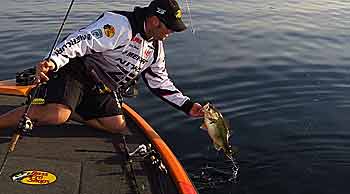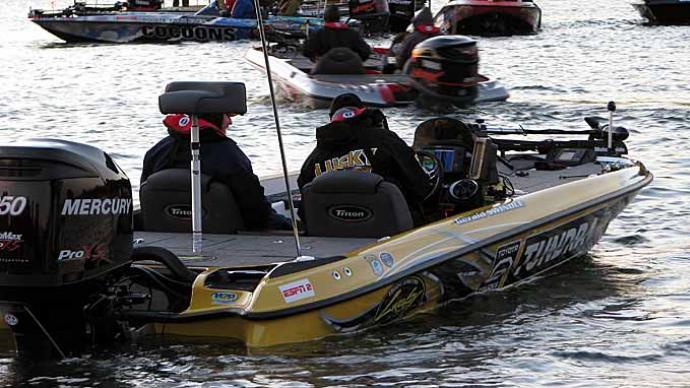
In a perfect world, tournament days for bass anglers include a slight cloud cover, gorgeous weather, active fish, perfect water temperature, and a full moon. However, reality comes crashing down, and these ideal conditions rarely occur. The best anglers are the ones who can roll with the punches and come up with a limit no matter how tough the fishing. The key is versatility.
Better anglers learn to adapt. For example, if their pre-fish patterns do not work for the first four hours of day one, they fall back on plan B. Adapting is something that Nitro pro Gary Senft of Arizona learned long ago.
Senft is one of the best-known tournament anglers in Arizona. This is because he has fished tournaments in Arizona since 1990 and is a regular seminar presenter at the Mesa, Ariz., Bass Pro Shops fish tank. He has been a pro-staffer for Bass Pro for almost eight years. Senft figures he does 50 to 60 seminars a year.
In Arizona, the lakes are used primarily to store water for residents of this desert state. Fish are not a high priority. Fishing in these waters can be a challenge. The lakes can quickly fill with muddy water after significant rain, but the water can drop just as quickly if the demand in the cities is high. Anglers pray for steady water levels from late winter/early spring through the spawn.
We went fishing with Senft in late January on Bartlett Lake. The water dropped a foot every three days. The rapid rise and fall of water in these Arizona lakes makes these bodies of water fish different every time an angler goes out. Senft fished five tournaments there during the past couple of months and won four. Now you know why his seminars at Bass Pro Shops packs them in!
The water temperature was 50 degrees, warming to 55 during the day. When we started fishing in the main lake, it was 53 degrees and colder in the river. In Arizona, this is a winter pattern. Senft told us that he had been on a good reaction bite in the early morning, and he looked for chunk rock at this time because the bass were feeding on crawdads. Windy banks are also good early, he told us, because the wind pushes the minnows up to shore. Crankbaits and spinnerbaits produced the most fish, but you had to fish them slowly. Still, this is an excellent way to cover ground and look for active fish.
“Conditions are tough today because of the half-moon, the cold, windy weather, and the falling water,” Senft said. Did I mention that a cold front was moving in, bringing clouds and chilly winds? Senft says that in his opinion, the moon affects the bite, and his table told him that today and the next day were the worst days for fishing all month. This is the kind of thing you find yourself facing on tournament days more often than you would like. Gary not only fishes tournaments, but he also guides on Bartlett. That must know what the fish are doing.
Gary looks for good rocky banks in the main lake near deep water this time of year. He prefers inside points with rocks that hold crawdads. Steeper banks are great because the fish can go up and down quickly. The bass like to run up and grab a quick meal. A steep bank allows the bass to go deep in a hurry when the water is steadily falling.
He keeps several crankbaits on and ready on the deck and picks them up based on the depth of the structure he’s fishing. He wants that bait to bump the bottom and loves the square billed baits because these baits deflect well and do not get snagged as often. Gary fishes a lot with crankbaits in the fall and winter because they are great limit baits – if he’s guiding, he wants numbers, and if he’s in a tournament, he wants a quick limit so he can relax and concentrate on culling. He checks the fish to see what they’ve been eating. The pad in the back of the bass’s throat is what Gary calls the “crusher.” If it’s red, he can tell they’ve been eating crawdads this morning. But that’s after we finally catch one. Because conditions have changed, so has the bite. Gary adapts.
Putting down the crankbait, Senft picks up a little Yum creature bait with an 1/8-ounce tungsten weight and starts casting it to shore, pitching it up, then drag-hopping it like a crawdad for a few yards. Even with this finesse lure, he flat covers the water. It’s a drop-shot rig, and when I ask him how long his leader is, he says, “As long as I want!”

He’s got a trick to make an adjustable drop shot using bobber stoppers. Bobber stoppers are tiny little egg-shaped bits that thread onto your line via the wire they are sold on. Gary slips one on the line, adds the hook, then another bobber stopper. The weight has to be tied onto this rig, not just snugged into a tight weight. He slides the bobber stoppers right up to the hook to hold it in place, and he can shorten or lengthen the leader any time he wants by simply sliding the hook and stoppers up or down the line.
The bobber stoppers come in a couple of sizes to fit snugly on different sizes of line, and they don’t slip around while you are fishing. But my first question was: how do you set the hook? Doesn’t the hook slide away and let the fish escape? Senft says everyone asks that, but it hasn’t been a problem for him. He’s boated plenty of fish with this rig, and he loves the convenience, plus not having to tie a knot at the hook keeps the light line from crimping and weakening.
Line twist can be a real problem with a drop shot rig. So, Gary uses a barrel swivel. The spinning rod is spooled up with 12- to 14-pound-test with a barrel swivel on end, then he attaches 5- to 7-pound test for the actual drop-shot rig. Another of his little tricks is to grab the hook and hold it firmly while using the other hand to bend the hook end slightly to the side. This small change has improved his hookset ratio. He also keeps a sharpening tool close and frequently touches up his hook points. With fine hooks and light line, the hook must penetrate with as little force as possible.
Gary says when he is in a tournament, he’ll make ten casts, and if he doesn’t get a bit, he moves on. With two guys in the boat, that’s a total of 20 casts. He says the fish are biting somewhere, so why waste time in an unproductive area? On this particular day, we moved from the chunk rock bank to a steeper bank, almost like a solid rock cliff. This kind of structure often holds the bass in winter. The bite was off and on all day long and almost backward in a way – with a finesse bite early and a reaction bite later in the day under overcast skies.
Like the pro that he is, Senft accepted the conditions and figured them out. We had a fantastic day.




